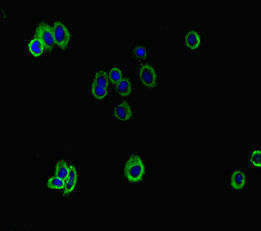| UniProt Protein Function: | ATP8B1: May play a role in the transport of aminophospholipids from the outer to the inner leaflet of various membranes and the maintenance of asymmetric distribution of phospholipids in the canicular membrane. May have a role in transport of bile acids into the canaliculus, uptake of bile acids from intestinal contents into intestinal mucosa or both. Defects in ATP8B1 are the cause of progressive familial intrahepatic cholestasis type 1 (PFIC1); also known as Byler disease. PFIC1 is an autosomal recessive disorder, characterized by early infancy cholestasis, that may be initially episodic but progresses to malnutrition, growth retardation and end-stage liver disease before adulthood. Defects in ATP8B1 are the cause of benign recurrent intrahepatic cholestasis type 1 (BRIC1); also known as Summerskill syndrome. BRIC is characterized by intermittent episodes of cholestasis without progression to liver failure. There is initial elevation of serum bile acids, followed by cholestatic jaundice which generally spontaneously resolves after periods of weeks to months. The cholestatic attacks vary in severity and duration. Patients are asymptomatic between episodes, both clinically and biochemically. Defects in ATP8B1 can be associated with intrahepatic cholestasis of pregnancy (ICP); also known as pregnancy-related cholestasis. ICP is a multifactorial liver disorder of pregnancy. It presents during the second or, more commonly, the third trimestre of pregnancy with intense pruritus which becomes more severe with advancing gestation and cholestasis. Cholestasis results from abnormal biliary transport from the liver into the small intestine. ICP causes fetal distress, spontaneous premature delivery and intrauterine death. ICP patients have spontaneous and progressive disappearance of cholestasis after delivery. Belongs to the cation transport ATPase (P-type) (TC 3.A.3) family. Type IV subfamily.Protein type: Membrane protein, integral; Hydrolase; Membrane protein, multi-pass; EC 3.6.3.1; Transporter, ion channel; TransporterChromosomal Location of Human Ortholog: 18q21.31Cellular Component: apical plasma membrane; endoplasmic reticulum; Golgi apparatus; plasma membraneMolecular Function: phospholipid-translocating ATPase activity; protein bindingBiological Process: Golgi organization and biogenesis; multidrug transport; negative regulation of transcription, DNA-dependent; phospholipid translocation; regulation of microvillus biogenesisDisease: Cholestasis, Benign Recurrent Intrahepatic, 1; Cholestasis, Intrahepatic, Of Pregnancy, 1; Cholestasis, Progressive Familial Intrahepatic, 1 |
| UniProt Protein Details: | |
| NCBI Summary: | This gene encodes a member of the P-type cation transport ATPase family, which belongs to the subfamily of aminophospholipid-transporting ATPases. The aminophospholipid translocases transport phosphatidylserine and phosphatidylethanolamine from one side of a bilayer to another. Mutations in this gene may result in progressive familial intrahepatic cholestasis type 1 and in benign recurrent intrahepatic cholestasis. [provided by RefSeq, Jul 2008] |
| UniProt Code: | O43520 |
| NCBI GenInfo Identifier: | 5031697 |
| NCBI Gene ID: | 5205 |
| NCBI Accession: | NP_005594.1 |
| UniProt Secondary Accession: | O43520,Q9BTP8 |
| UniProt Related Accession: | O43520 |
| Molecular Weight: | 143,695 Da |
| NCBI Full Name: | phospholipid-transporting ATPase IC |
| NCBI Synonym Full Names: | ATPase phospholipid transporting 8B1 |
| NCBI Official Symbol: | ATP8B1 |
| NCBI Official Synonym Symbols: | BRIC; FIC1; ICP1; PFIC; ATPIC; PFIC1 |
| NCBI Protein Information: | phospholipid-transporting ATPase IC |
| UniProt Protein Name: | Phospholipid-transporting ATPase IC |
| UniProt Synonym Protein Names: | ATPase class I type 8B member 1; Familial intrahepatic cholestasis type 1; P4-ATPase flippase complex alpha subunit ATP8B1 |
| Protein Family: | Phospholipid-transporting ATPase |
| UniProt Gene Name: | ATP8B1 |
| UniProt Entry Name: | AT8B1_HUMAN |







